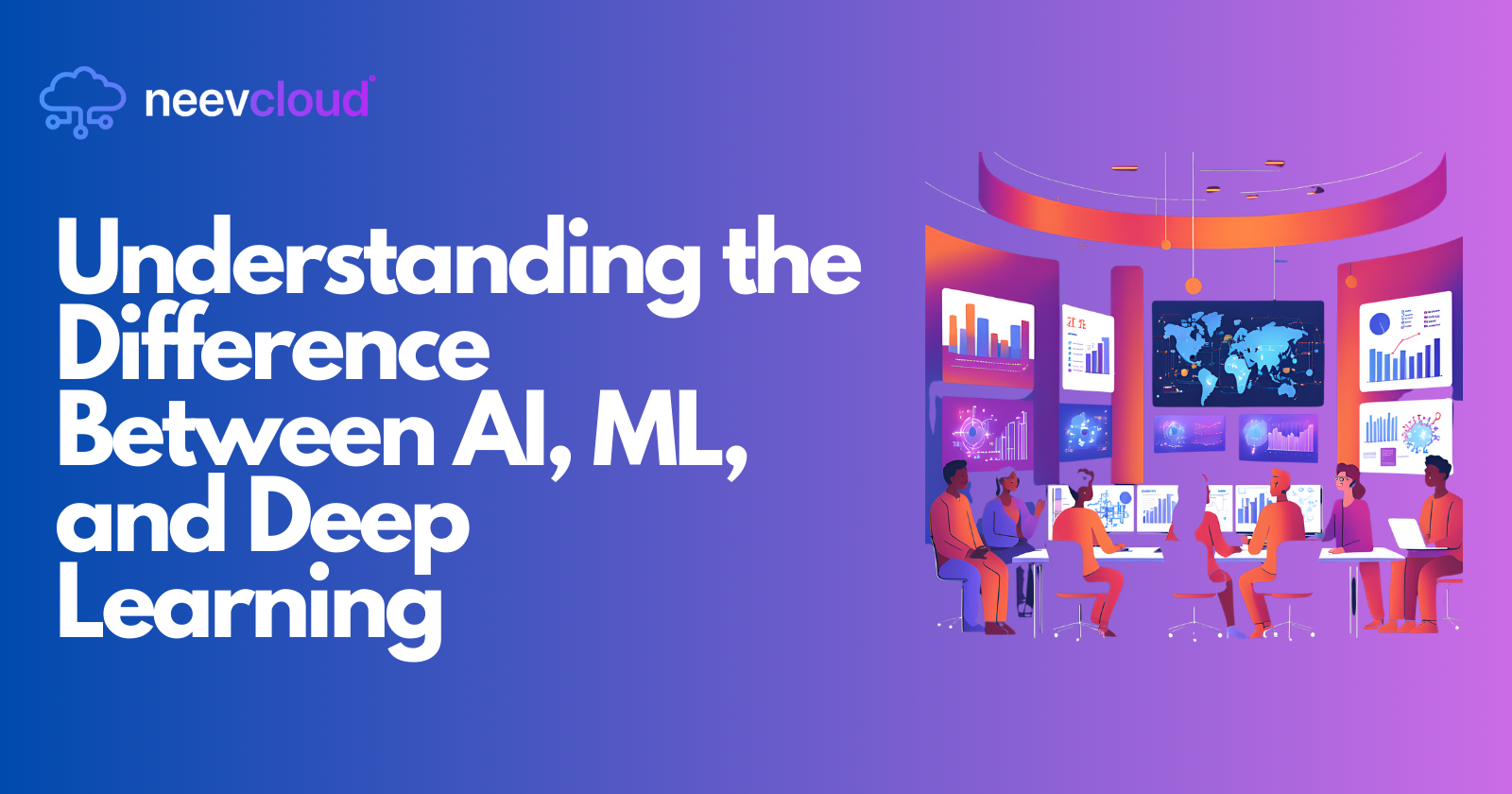Understanding the Difference Between AI, ML, and Deep Learning
 Tanvi Ausare
Tanvi Ausare
The terms Artificial Intelligence (AI), Machine Learning (ML), and Deep Learning (DL) are often used interchangeably, creating confusion even among tech enthusiasts. These technologies are interconnected, yet they have distinct purposes and applications. In this blog post, we will unravel the differences between these terms and how they interact within the AI Cloud and AI Datacenter landscapes.
What is Artificial Intelligence (AI)?
AI refers to the simulation of human intelligence by machines. Its goal is to enable systems to think, reason, and make decisions like humans.
Key characteristics of AI:
Mimics human cognition (e.g., problem-solving, learning, and reasoning).
Incorporates a wide range of subfields, including ML and DL.
Operates in rule-based systems or learns dynamically.
Examples of AI applications:
Chatbots capable of understanding and responding to queries.
Self-driving cars leveraging sensory input for decision-making.
AI-driven tools for AI Datacenters to optimize resource allocation.
AI Cloud in Action: AI in the cloud leverages scalable computing power to process complex tasks like natural language processing, image recognition, and predictive analytics.
Machine Learning: A Subset of AI
Machine Learning is a branch of AI that focuses on creating systems capable of learning from data without being explicitly programmed. ML uses algorithms to identify patterns and make predictions.
Key characteristics of ML:
Relies on structured data to learn and improve performance.
Divided into supervised, unsupervised, and reinforcement learning.
Focuses on specific tasks rather than general intelligence.
Examples of ML applications:
Fraud detection in banking systems.
Recommendation engines for streaming services.
Predictive analytics tools for healthcare.
Types of Machine Learning Algorithms:
Supervised Learning: Trains on labeled data (e.g., spam email detection).
Unsupervised Learning: Discovers hidden patterns in unlabeled data (e.g., customer segmentation).
Reinforcement Learning: Learns through trial and error in dynamic environments (e.g., robotics control systems).
Machine Learning in AI Datacenters:
Automates data analytics pipelines.
Improves energy efficiency through predictive modeling.
Enhances system uptime with anomaly detection algorithms.
Deep Learning: The Next Evolution
Deep Learning is a subset of ML inspired by the structure and function of the human brain. It uses neural networks with many layers (hence "deep") to model complex patterns.
Key characteristics of DL:
Requires large datasets and significant computing power.
Utilizes neural networks to perform tasks like image and speech recognition.
Excels in processing unstructured data such as images, audio, and text.
Examples of Deep Learning applications:
Autonomous vehicle navigation systems.
Virtual assistants like Siri and Alexa.
Real-time translation tools.
Deep Learning Architecture:
Convolutional Neural Networks (CNNs): Best for image recognition tasks.
Recurrent Neural Networks (RNNs): Suited for sequential data like time series.
Transformer Networks: Powering large-scale language models like GPT.
Deep Learning and the AI Cloud:
DL models require immense computational resources, often provided by Cloud GPUs.
The scalability of AI Clouds makes them ideal for training large DL models.
Cloud-based DL accelerates research in fields like genomics and climate science.
Key Differences: AI vs. ML vs. Deep Learning
Here’s a breakdown of how AI, ML, and DL differ in scope and application:
| Aspect | AI | Machine Learning | Deep Learning |
| Definition | Broad concept of smart machines | AI subset focused on data-driven learning | ML subset using layered neural networks |
| Goal | Simulate human intelligence | Learn from data to make predictions | Mimic brain function for complex tasks |
| Complexity | Moderate | High | Very high |
| Computational Power | Low to moderate | Moderate | High |
| Examples | Chatbots, robots | Spam filters, predictive analytics | Self-driving cars, voice assistants |
Why These Technologies Matter in the Cloud Ecosystem
The cloud ecosystem plays a pivotal role in the development and deployment of AI, ML, and DL solutions. Here's how:
AI in the Cloud
AI Clouds enable real-time decision-making by hosting AI models.
Businesses can utilize AI-powered APIs for computer vision, NLP, and more.
AI supports autonomous operations in AI Datacenters, reducing manual interventions.
Machine Learning in Cloud Environments
Cloud GPUs accelerate the training of ML models by handling parallel computations.
ML algorithms optimize cloud resource management, enhancing performance and cost efficiency.
Scalable cloud solutions enable startups to deploy ML-powered applications without heavy infrastructure investments.
Deep Learning with Cloud GPUs
DL relies on Cloud GPU clusters to process massive datasets quickly.
The AI Cloud supports experiments with neural networks, enabling cutting-edge research.
Pre-trained DL models on the cloud save development time for businesses.
Real-World Use Cases of AI, ML, and Deep Learning
In Healthcare:
AI: Predicts disease outbreaks using historical and real-time data.
ML: Identifies high-risk patients through pattern analysis.
DL: Powers diagnostic tools like X-ray image interpretation.
In Retail:
AI: Enhances customer engagement with virtual shopping assistants.
ML: Predicts consumer behavior for targeted marketing.
DL: Automates inventory management with image recognition.
In AI Datacenters:
AI optimizes resource allocation, boosting efficiency.
ML detects anomalies in network traffic, ensuring security.
DL models predict hardware failures, reducing downtime.
Challenges in Adopting AI, ML, and Deep Learning
While these technologies offer immense benefits, businesses face challenges like:
Data requirements: ML and DL models need vast amounts of high-quality data.
Computational costs: Training DL models demands significant computational resources, often mitigated by Cloud GPUs.
Talent gap: Specialized expertise is required to develop and deploy advanced models.
Overcoming these challenges with AI Clouds:
Leveraging pre-configured ML and DL tools.
Accessing scalable infrastructure for experimentation and deployment.
Using intuitive interfaces to minimize the need for in-depth technical skills.
How NeevCloud Supports AI, ML, and Deep Learning
At NeevCloud, we empower businesses to unlock the potential of AI, ML, and DL through robust cloud solutions.
Key offerings:
AI Cloud Solutions: Enabling seamless deployment of AI models.
Cloud GPUs: Providing the computational power needed for ML and DL tasks.
AI Datacenter Integration: Optimizing performance and scalability for enterprise applications.
Conclusion
Understanding the differences between AI, ML, and Deep Learning is crucial for businesses aiming to leverage these technologies effectively. While AI serves as the overarching concept, ML provides data-driven learning, and DL focuses on solving complex problems using neural networks.
By harnessing the power of AI Cloud and AI Datacenter, businesses can accelerate innovation, optimize operations, and gain a competitive edge in their industries. With NeevCloud, you have the tools and expertise to navigate this exciting technological frontier.
Ready to explore? Let NeevCloud be your guide in this journey toward intelligent automation.
Subscribe to my newsletter
Read articles from Tanvi Ausare directly inside your inbox. Subscribe to the newsletter, and don't miss out.
Written by
